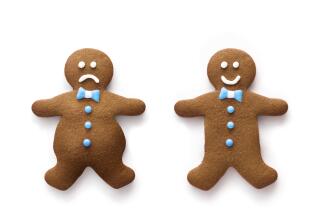Getting Facts Straight Is Key to Getting in Shape
Remember when you resolved that 1991 would be the year you finally got in shape? And remember how you forgot that promise youâd made to yourself when things did not work out according to plan?
It may be too late for this year, but you can always try again in â92. And donât kick yourself too hard for not succeeding so far--it may not be all your fault. Part of the problem may have been the bogus weight-lifting advice you got from your brother-in-law, the fad diet your co-worker photocopied for you, or maybe even the lesson you got from Mom way back when.
Such fitness fiction often leads directly to failure, say personal trainers who spend much of their time trying to replace their clientsâ erroneous assumptions and misinformation with fitness facts.
âPeople set themselves up for failure,â says Dana Point trainer Lou Gaudio. âThey base their program on these myths and then when they donât work, they quit.â
Trainers understand that many prevalent falsehoods are popular because they make getting in shape seem easier than it is. But too often, these get-fit-quick schemes lead their followers not only to failure, but to guilt and frustration as well.
The most popular fitness fibs fall under the heading of âNo pain, no gain,â the experts say.
The exercise rallying cry of the â80s has been long since abandoned by those in the know, but among the sweaty masses it still echoes despite all efforts to silence it. Like the villain in a horror movie, this myth just keeps coming back, albeit in new and varying disguises.
For example:
If a little exercise is good, then more is better, right?
Wrong, says exercise physiologist Pam Deegan. She hears this most often from people who try to do too much, too soon.
âIt takes your tendons, ligaments, muscles a couple of months to adjust to the stress being put on them by exercise,â says Deegan, who chairs the schools of health science, physical education and athletics at Irvine Valley College. âAnd your heart especially needs time to adjust.â
Too many people begin a new fitness program with a long, hard workout, only to find themselves so sore they can hardly move the next day. Often these people never get around to a second workout until months later, when they take the same gung-ho approach and get the same painful results.
âIf it took you six years to get out of shape, you canât get back into shape in a month,â Deegan says.
Another related pitfall is scheduling more workouts than you will have time or energy to do, Gaudio says. Ambition is admirable, but you will have a better chance of success if you set realistic goals. Start with slow and easy workouts three days a week, rather than a grueling session every day.
Others push themselves too hard in another way, taking it so hard and fast they become breathless. You may feel as though you are accomplishing a lot when that happens, but Deegan says such intense exercise is anaerobic because the body becomes deprived of oxygen. And without oxygen, it is impossible to burn fat.
How about sweating? Thatâs good, right?
Wrong, Deegan says. âPeople associate sweating with weight loss, but sweat is part of the bodyâs air-conditioning system. It has nothing to do with fat-burning. I know people who wear rubberized suits or even trash bags--with a hole for their head to stick through--so theyâll sweat more. Actually all theyâre doing is losing water weight, and that kind of dehydration is dangerous and could even be fatal.â
Another cousin of âNo pain, no gainâ is the idea that it is best to âwork throughâ an injury.
âThat is really dangerous,â says Leslie Davis, a personal trainer who works out of the SportsClub/Irvine. âIf it hurts, stop. Thatâs the bodyâs signal that thereâs something wrong. With a soft tissue injury or something involving a joint, you need attention from somebody who understands what may have gone on. That can speed the healing process so much. A lot of times if you get the right treatment, itâs just two days of ice and aspirin and youâll be fine.â
Doesnât exercise increase the chance of injury? Yes and no, the experts say.
For weekend warriors who are not in shape but enjoy an occasional all-out game of softball or basketball, this one is true, Gaudio says. But a consistent program of sensible exercise makes the body stronger, more flexible, and less injury-prone.
Speaking of weekend warriors, a lot of aging jocks out there assume that once you are an athlete, you will always be an athlete. If you have not played tennis or gone surfing since high school, do not assume you will be able to go out and pick up where you left off (unless you are from the class of â91).
âA lot of people have let it slip away and they donât realize theyâre in bad shape now,â Gaudio says.
Another prevalent assumption is that when you stop working out, all that muscle will turn to fat. âThatâs like saying your liver will turn into your kidneys,â Deegan says. âTheyâre two completely separate types of tissue.â
Instead, what happens is that muscles atrophy when they are not used. And if you are eating the same amount for an inactive lifestyle as you did when you exercised, your fatty tissue will grow to store the unneeded calories.
This is one of Gaudioâs favorite myths: âA pound of muscle weighs more than a pound of fat.â Not true, he explains over and over. âThey weigh the same,â he says. âBut muscle takes up less space.â
Davis says many of her clients are more concerned with weight than size, and when they start building muscle and therefore gaining weight, they panic. âI try to get them to understand that you can be a lot smaller and still weigh a lot,â she says.
Many clients just want to lose fat in certain areas, a myth known as spot reducing. âYou can do spot toning, but not spot reducing,â Davis says.
âFat doesnât come off in spots,â Deegan says. âWhen you do a sit-up, all youâre doing is strengthening a muscle. Youâre not doing anything aerobic, so youâre not burning fat. And aerobic exercise is the only way to burn fat.â
Speaking of fat, forget what you have heard on those late-night infomercials: Thereâs no such thing as cellulite. That unsightly padding on your thighs is simply fat that has lost its elasticity, Deegan says. And the only way to get rid of it is to burn it off with a low-fat diet and regular aerobic exercise.
Many women are afraid that if they lift weights to strengthen and shape their bodies, they will end up looking like men. Without artificial steroids, that just wonât happen, the experts say. Davis, a world champion outrigger canoe team member, lifts weights to make her upper body stronger. âWomen donât naturally retain muscle tissue because they donât have the hormones for it,â she says.
For all the myths about exercise, there are at least as many concerning diet.
For starters, the idea of âgoing on a dietâ is a myth, the experts say. âYou canât think about losing weight and then going back to your old ways,â Deegan says. âIt just doesnât work. There has to be a lifestyle change, and you have to exercise along with it.â
Fasting to lose weight is even worse. âWhen you donât eat, or you eat too little, probably only 40% of the weight loss you get is from your fat store. The rest is muscle mass, which is protein,â says Deegan. âAnd when you donât get enough nutrients, your metabolic rate is lowered, so that you burn even less.â
Davis says, âI hear from a lot of people who say, âIâm trying to lose weight, so I only eat one meal a day.â They starve all day long, then they eat dinner with their family and then go to sleep on it. What that does is all day long, your body thinks itâs being starved, so it guards your calories by lowering your metabolism. Then when you go to sleep, your metabolism drops even more, and that just makes it worse.â
Everyoneâs heard of carbo-loading, right? That is what endurance athletes do just before a race, and it does help them make it through. But if you are not an endurance athlete and you do not have an event coming up, do not load up.
âPeople have heard that carbohydrates are good for them, so they eat them,â Davis says. âThe problem is, they eat them like an endurance athlete, and the excess calories just get stored as fat.â
Do not overdo protein, either. âI still hear people say that if you just eat protein, you can lose a lot of weight. But that really isnât safe. Too much protein is hard on your kidneys, and there are a lot more toxic byproducts than from carbohydrates,â Davis says. âThe best approach is balance.â
Speaking of protein, it is also a myth that protein builds muscle, Davis says. âActually, exercise builds muscles.â
And finally, switching from butter to margarine may lower your cholesterol level, but it does not save you any calories. Both are fat, and both have the same number of calories, 9 in each gram.


